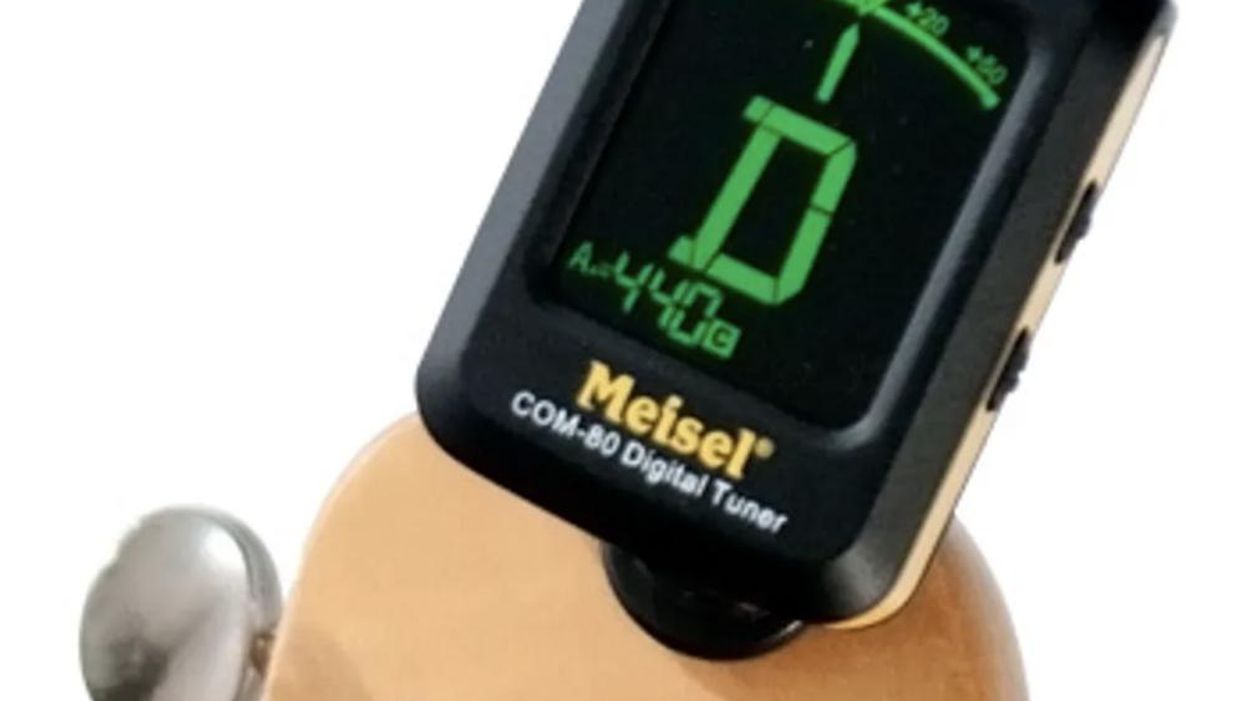For musicians, there is no accessory more important than a tuner. Most professional musicians will tell you that keeping your instrument in tune at all times is among the most important pieces of playing, if not the most important. Playing out of tune will quickly label you as an amateur, no matter how impressive your chops are.
For musicians, there is no accessory more important than a tuner. Most professional musicians will tell you that keeping your instrument in tune at all times is among the most important pieces of playing, if not the most important. Playing out of tune will quickly label you as an amateur, no matter how impressive your chops are.
Luckily, technology has kept up with the need for precise tuning. Be you a weekend warrior, pro, or technician, the market is literally flooded with options to help us all make sure our instruments are in check, ranging from floor pedals to rack units to mobile apps. Clip-on tuners have always been a popular choice for musicians on the go, and we recently gave ten of them a look. Evaluating the tuners on their own didn't seem like a proper trial, so we compared them to the Fishman F1 Aura's tuner onboard a Martin GPCPA1 acoustic, and a TC Electronic PolyTune paired with a Fender American Telecaster.
Korg Pitchclip PC-1 Clip-On Tuner
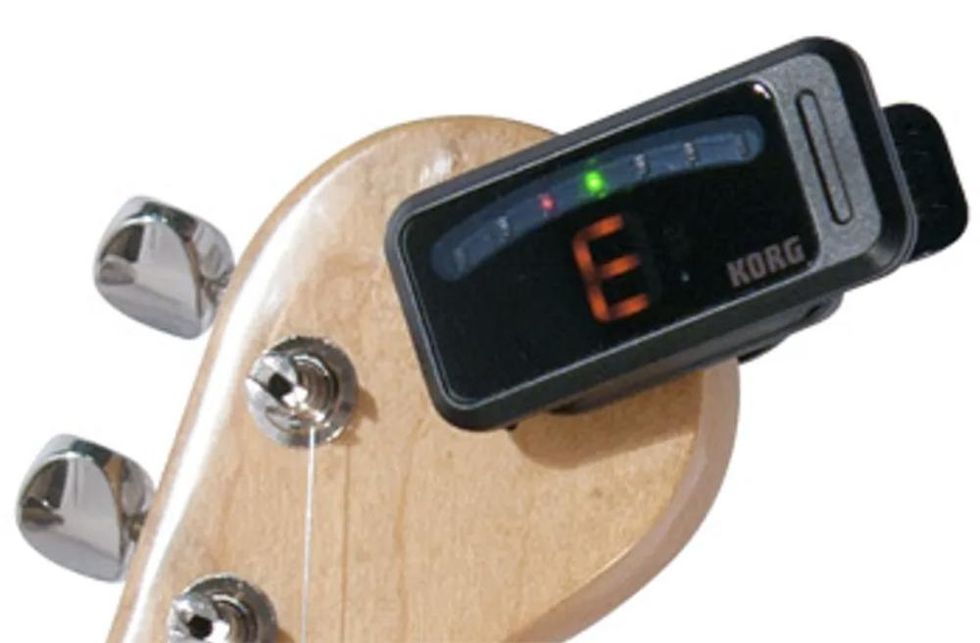
- Tuning Range: A0 - C8
- Extremely compact
- Single chromatic tuning mode for guitar and bass
- Reversible display readout, easy to read
- Korg rates precision +/-1 cent
In the world of tuners, Korg is a king. Their highly accurate rackmount tuners and compact tuners are popular among seasoned pros and everyday musicians alike—in fact, many players' first tuners bore Korg name on their plastic housings.
The Pitchclip is a distant cousin of the company's extremely popular Pitchblack pedal tuner. It's one of the smallest tuners of the bunch, with a vivid LED display that pops up at a maximum angle of 120 degrees from its clip. There are no extra bells and whistles programmed into the Pitchclip, only a single chromatic tuning mode that covers the tuning ranges for guitar and bass.
My first impression was that the Pitchclip's clip felt loose in my fingers, but I was pleasantly surprised when I clipped it to the Tele's headstock and gave the neck a good shake—the Pitchclip didn't budge. Though the display only tilts up or down, Korg built in the fantastic feature of reversing the display meter on the LED by holding the power button for more than one second. This allowed me to place the tuner pretty much anywhere I wanted and still be able to read the screen.
Compared to the PolyTune, the tuning accuracy with the Pitchclip on the Tele was decent. Starting out of tune, I was easily able to pull the notes into an accurate tuning, but it was more difficult to get a perfectly precise read, each string readout wavered between in tune, slightly sharp, and slightly flat. Placing the tuner on the meatier middle part of the headstock helped stabilize the readings a bit, but not completely. However, the accuracy was much improved with the Martin, with only slight shaking on the low E string.
Street: $19.99
korg.com
Meisel COM-80 Digital Tuner
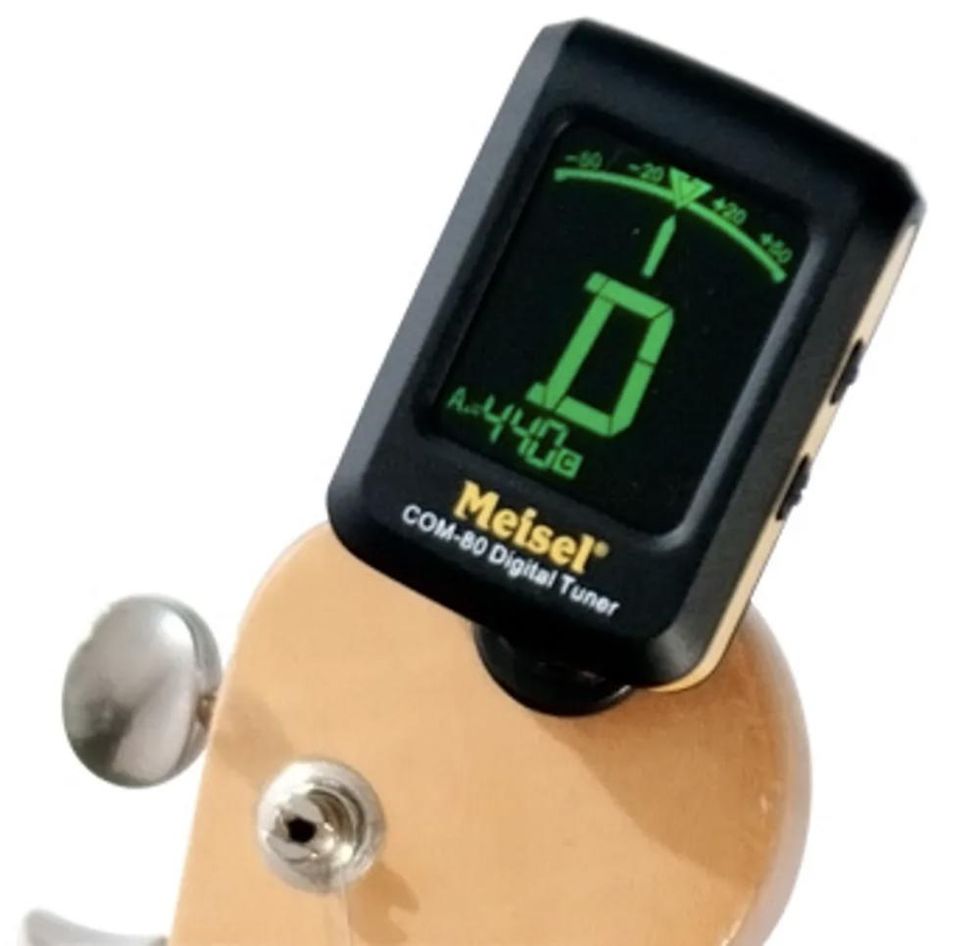
- Tuning range: A0 - A3
- Calibration: 410 Hz - 450 Hz
- Calibrated tuning modes for guitar, bass, ukulele, and violin, plus a chromatic tuning mode
- Bright and easy to read display
- Great accuracy
Structurally, the COM-80 was a solid little tuner. The clip leading up to its large, Tamagotchi-style LCD screen had a strong and tight bond against both headstocks, aided by the clip's silica gel padding. The device came equipped with calibrated chromatic tuning modes for guitar, bass, violin, and ukulele. It also has an adjustable pitch mode that gave me the option of moving the range between 410 Hz and 450 Hz.
The accuracy of the COM-80 against the PolyTune was quite impressive when I corrected the purposefully-out-of-whack tuning of the Telecaster, with a bright and easy to read display to boot. If the pitch fell flat or rose sharp, the screen quickly changed its color from green (in tune) to orange. Thankfully, the COM-80 didn't exhibit any sort of pitch "warble," which is a common problem with tuners of the clip-on variety. The tuning was even more precise on the Martin, which was likely due to the acoustic resonance of the guitar.
The only major drawback I experienced with this tuner was the inability to rotate the screen from side to side. I was able to twist it around freely on its little plastic tree, but could only tilt it up or down from there. Because I had the tuner clipped on the tip of the Tele's headstock—so it wouldn't touch the tuning pegs—I could only read the LCD display sideways. The COM-80 is a great tuner, but it could use a little more flexibility on the mounting of the LCD display.
Street: $23.95
Intellitouch PT40 Rechargeable Tuner
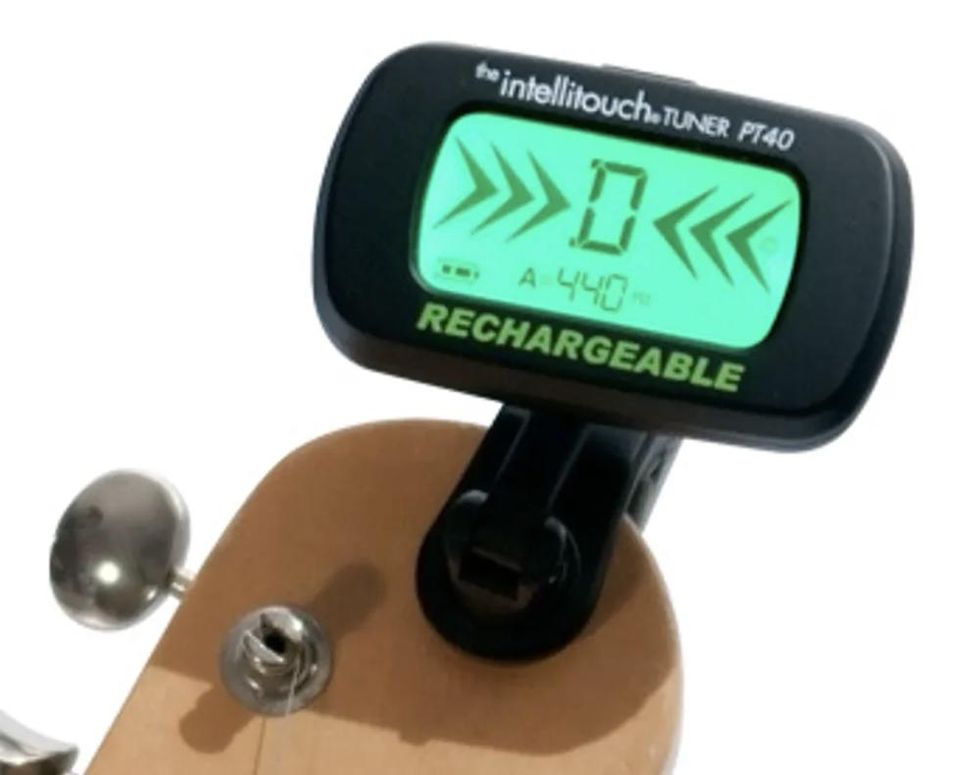
- Calibration: 430 Hz - 450 Hz
- No battery, recharges from USB power source (via included cable or third-party charger)
- Excellent mobility for screen positioning
- Bright, two-color screen
The PT40 is a rather unique tuner in that it doesn't use a conventional battery. Instead, it relies on a built-in rechargeable power source that gets its charge through the included USB cable (or any other USB power source). This is a pretty neat feature for those on the go—and on a budget—but a little inconvenient for players who don't have a USB power source handy. The documentation failed to mention how long the battery holds a charge, but pointed out that the tuner saves battery by automatically switching off after two minutes, if a vibration isn't present.
Regardless, the PT40 performed admirably with the Martin, and I had absolutely no issues moving the screen around to a comfortable position. Both the screen and its clip tree were completely free to move, offering 360 degree movement in any direction. This was great and made it possible to leave the tuner tucked behind the guitar's headstock, completely out of the way when I didn't need it.
Compared to the PolyTune, the accuracy of the PT40 was decent, but a little problematic at times. Pitch readouts would wobble between sharp and in tune frequently, especially when tuning down a whole step. Reading the LCD was easy though, and I was impressed by its legibility and color-coding between green (in tune) and a rather alarming shade of red (flat or sharp). With the Martin, the tuner's accuracy improved significantly, again likely due to the added acoustic resonance.
Street: $35.95
Fishman FT-1 Digital Tuner
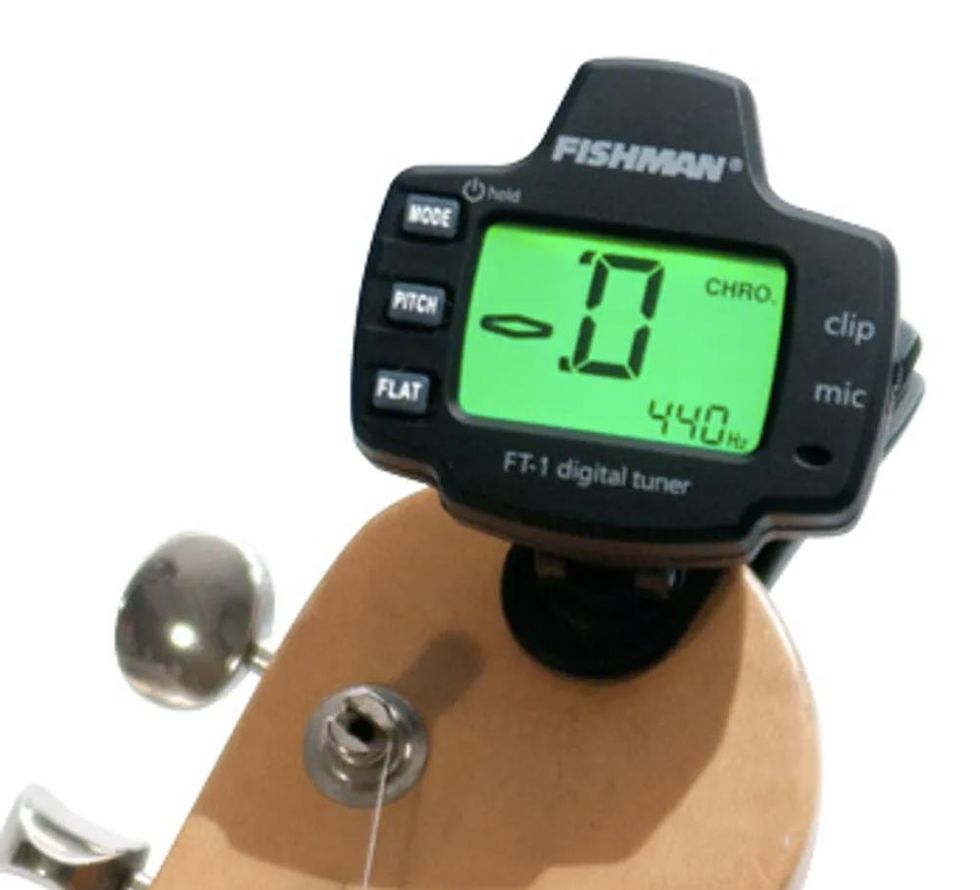
- Tuning Range: A0 - C8
- Calibration: 435 Hz - 445 Hz
- Modes for chromatic, 6- and 7-string guitar, bass, and ukulele
- Easy to reach controls
- Built-in switchable mic
- Extremely vibrant display
Even though they're primarily known for acoustic instrument pickups, Fishman's FT-1 clip-on tuner is a device worthy of its own attention, even with a few quirks. It's one of the smallest tuners in this roundup, and also one of the hardest to position on a guitar's headstock. The LCD screen could only be moved up and down, and the tree it sat on had 360 degree access. After clipping the tuner to the tip of the Martin's headstock, I noticed it wouldn't have mattered if the LCD screen could move from side to side—the tree it sat on was so short, it wouldn't have had enough room to clear the headstock at a right angle for easy viewing. I had to strain my neck at an angle to read it, or move the guitar around to get a good look.
That's not to say that the FT-1 isn't a worthwhile little tuner. Multiple chromatic tuning modes for guitar, bass, and ukulele are present. A flat selection and a built-in mic round out the features of the tuner, which has one of the clearest displays in the bunch. The tuner's flat and sharp indicator arrows moved smoothly as I adjusted each string's pitch, and I didn't have any warble between semitones when dropping the tuning.
Even with the tuner set at 440 Hz, the range seemed a little sharp in pitch when compared to the PolyTune, and a few of the other tuners in the roundup. It wasn't a major difference that most people would even hear, but visible by a few cents in pitch.
Street: $24.95
fishman.com
GFS GFT-40 Guitar & Bass Tuner
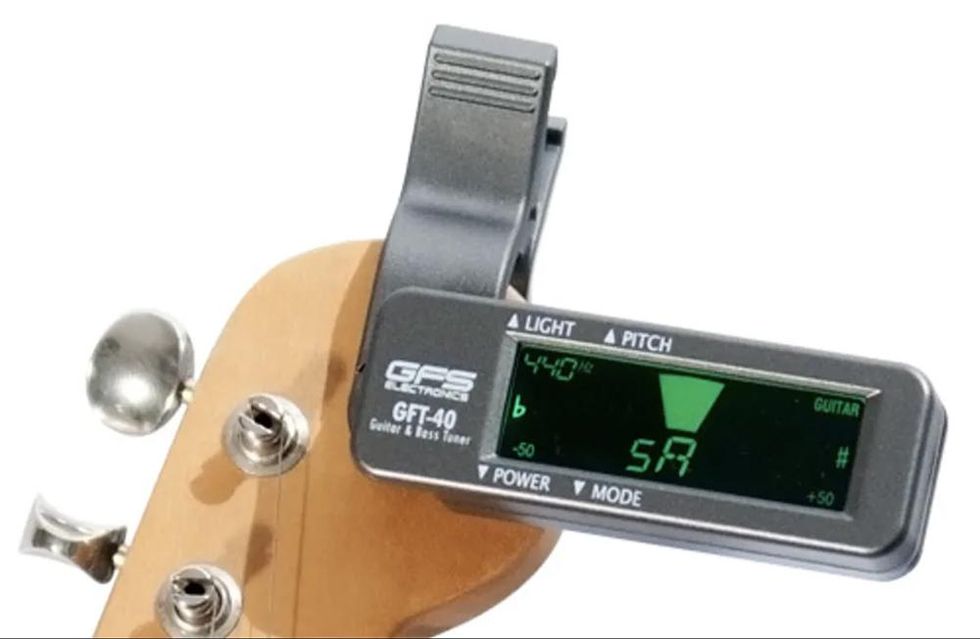
- Inexpensive and lightweight, but flimsy feel
- Very tight clip with a good amount of grip
- Good tuning accuracy
- LCD hard to read at angles
With a tight, snappy clip and a bright, highly legible display, the GFT-40 is the least expensive tuner of the bunch. The tuner's four buttons—one each for pitch adjustment, tuning mode, power, and backlight activation—were nestled on the back of the LCD display's plastic housing, a smart design decision which helps avoid any sort of accidental setting changes. Due to the clip's thick and ribbed rubber padding, I got a strong bond on both headstocks. It was difficult for me to move the entire tuner around without actually releasing the clip—this was nice and made the tuner feel substantial.
What didn't feel substantial was the tuner's overall build. The housing felt a little flimsy in my hand and gave me the feeling that its days might be numbered if I accidentally dropped it on a hard floor.
Despite the questionable quality of the build, the GFT-40 had a good amount of tuning accuracy and readability from its LCD screen—if the screen was adjusted to a head-on angle with my point of view. The display had the welcome feature of switching from blue to green when in tune. However, when I shifted the tuner slightly upwards or downwards, the screen showed a noticeable amount of washout, similar to looking at an inexpensive computer display or DLP television from the side. When compared to both the PolyTune and the F1 Aura, the tuning was only about a cent flat from the actual pitch—an impressive feat for such an inexpensive tuner.
Street: $14.95
guitarfetish.com
Seiko STX2 Clip-On Chromatic Tuner
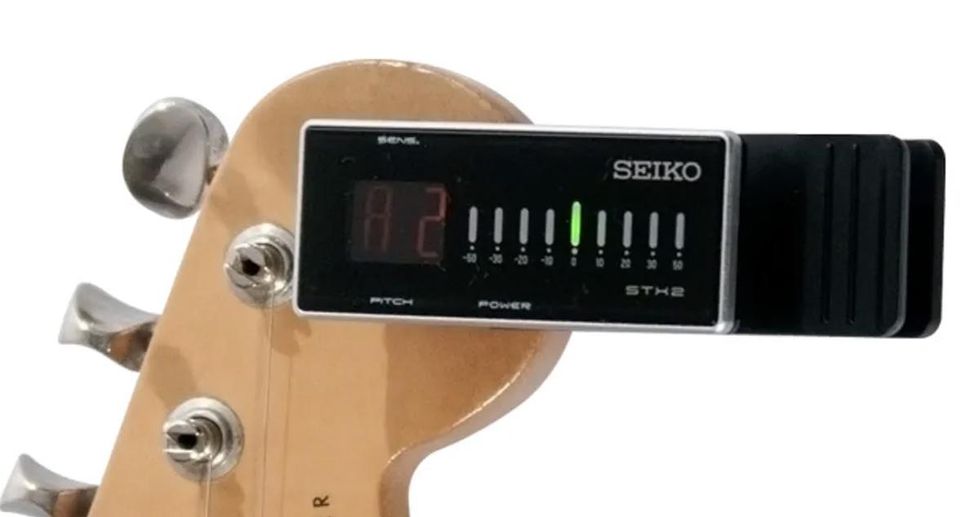
Seiko has long been known for portable electronics, most notably for wristwatches. For many of us, our first digital watches in the '80s bore their name. The company's STX2 clip-on tuner actually has a similar look of their timepieces of yesteryear, along with near pinpoint accuracy.
One of the STX2's biggest strengths is its ability to be folded up into an easily pocketable unit. The look is delightfully retro, right down to the tuner's nine individual tuning indicators. The clip is only about an inch longer than the tuning display itself, and it attached firmly to both guitars with ease. Inside the clip is a thick strip of rubber that fits snugly against a headstock, which helped with the clip's tight coupling.
Tuning accuracy with the Seiko was excellent on both the Tele and Martin. I was even able to pick up some intonation issues with the tuner after I plucked a harmonic on the Tele's 6th string at the 12th fret. This was after I engaged the built-in sensitivity modulation function (which was designed to block out background interference like tuning in a noisy room) but it still stood out as being pretty extraordinary nonetheless. Being able to detect an intonation issue like this with a simple clip-on tuner is normally unheard of.
The STX2 could be positioned pretty much any way I wanted, except I couldn't twist the tuner readout around. Luckily, the readout was mounted on its own slider clip, allowing me to pop it out, flip it, and slide it back in, albeit with a little more effort than it should have required.
Street: $44.99
Rotosound AMT 530 Tuner & Metronome
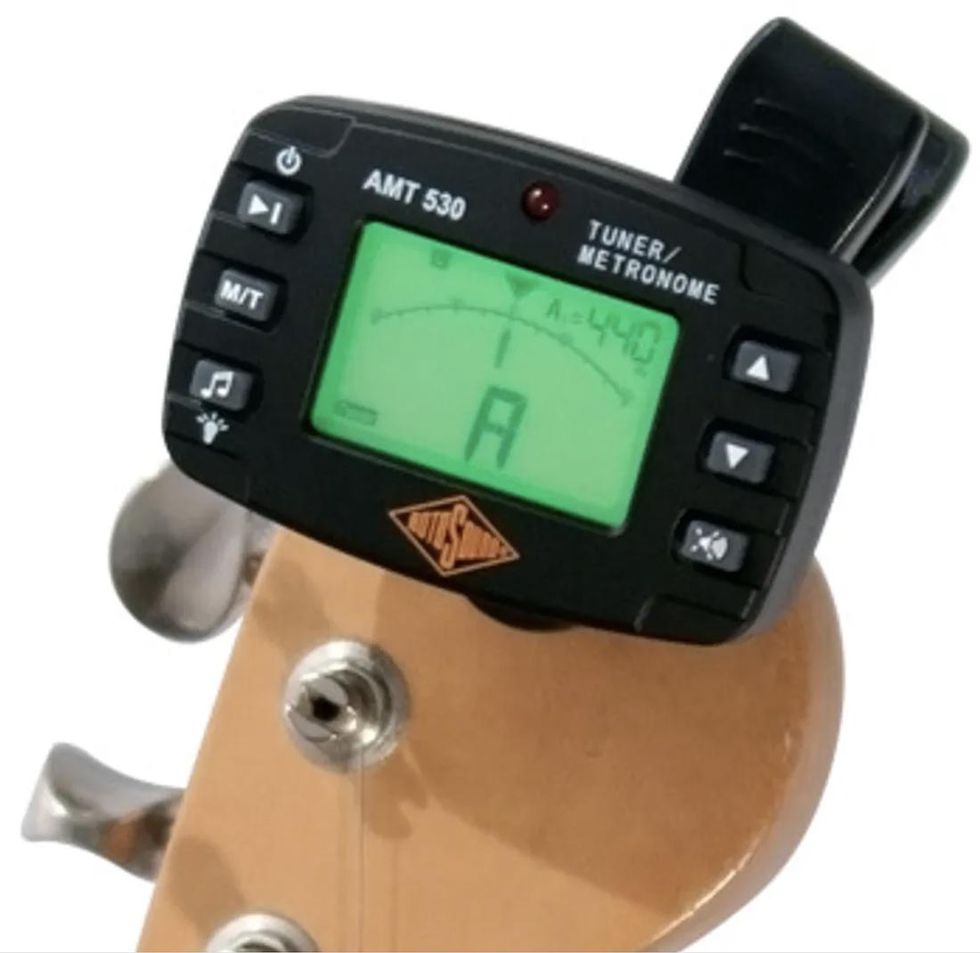
- Tuning Range: A0 - C8
- Calibration: 430 Hz - 460 Hz
- Metronome tempo range: 30 bpm - 260 bpm
- Limited mobility
- Bright, vivid display
Rotosound—one of the oldest players in the electric guitar string scene—managed to produce a pretty nice tuner for the money with the AMT 530. The diminutive clip-on tuner is almost small enough to tuck into my front pocket comfortably, and had great tuning accuracy when compared to the Martin's onboard tuner. It faltered a little on the high strings of the Tele, forcing me to move the tuner around the headstock to locate a spot where it could pick up the guitar's vibrations a little better. In addition, the tuning indicators were a little jumpy as soon as I approached the in tune note, hopping between sharp and flat frequently—as if it couldn't decide if the tuning was correct or not.
Despite the small issues while tuning the electric guitar, the AMT 530's built-in metronome was a real treat to play with. I was pretty amazed at just how loud it was capable of getting, with it sometimes approaching levels loud enough to be heard in a noisy office. It was super easy for me to change the beat via the front panel's controls for tempo, beats, and rhythm patterns, and the display's backlight made everything simple to read and adjust. Unfortunately, I was unable to twist the tuner's readout, which meant I had to read it on its side when I was holding the guitar. It seemed as if it was designed for a guitar that would be lying flat on a bench.
Street: $18.99
rotosound.com
Snark SN-1 Clip-On Chromatic Tuner
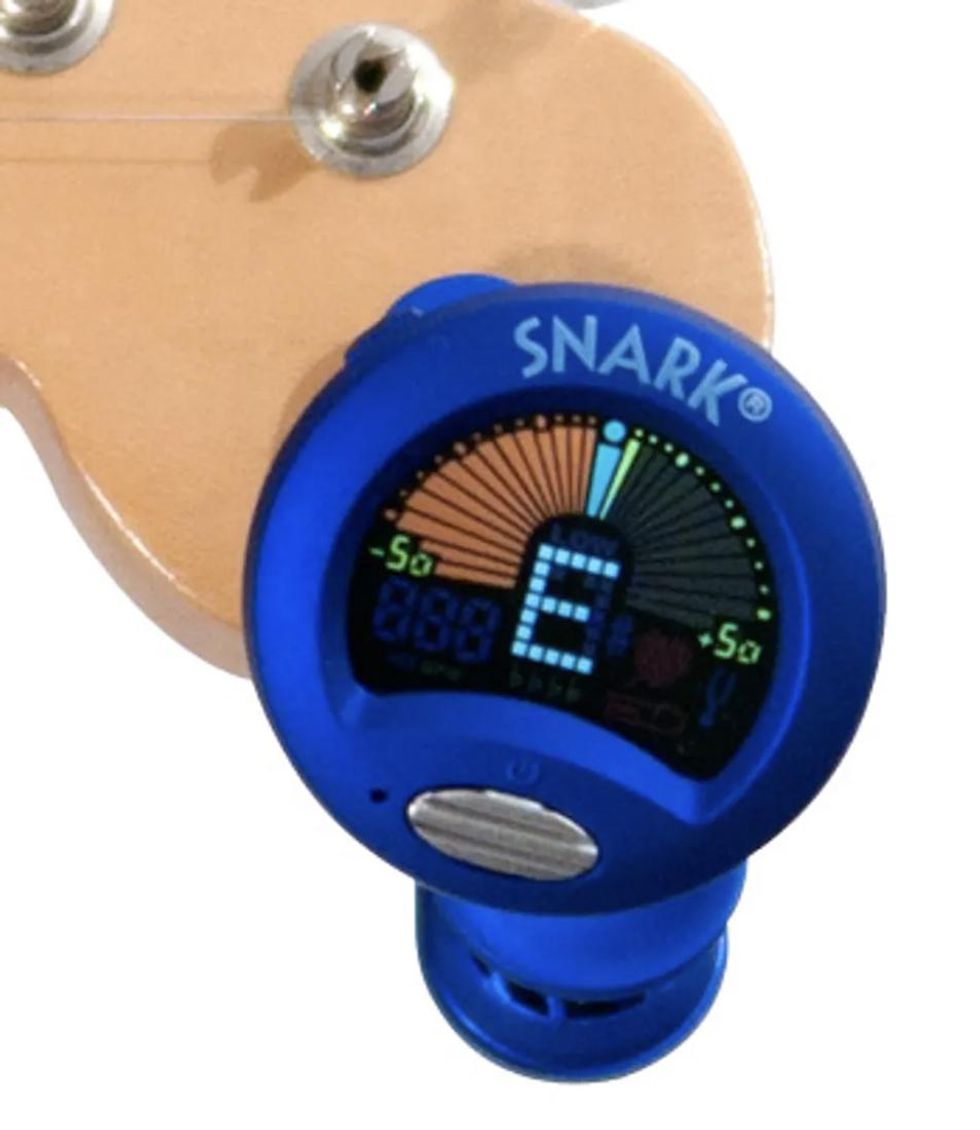
- Calibration: 415 Hz - 466 Hz
- Colorful, easy to read display
- 360 degree display rotation
- Tap tempo metronome
Just a little under 20 bones, the SN-1 gets high marks in every category, including an LCD that was very easy on the eyes, a high-degree of mobility, extraordinary tuning accuracy, a tough build, and a fantastic built-in metronome. It has a whimsical look that conjures up thoughts of the kind of tuner that Dr. Seuss might dream up, which may not appeal to all.
The tuner's "stay put" clip had the perfect amount of resistance to my fingers, and the little rubber strip inside the clip conformed to the shape of the Martin and Tele headstock edges well. Both the LCD and its plastic tree had almost complete freedom to be moved in a 360 degree motion, and be tilted in any direction as well. This made the tuner flexible for both right- and left-handed guitarists.
When compared to the F1 Aura and PolyTune, the Snark was pretty much dead-on with their readings. I was impressed at how well it interpreted each guitar's tunings when it was placed at various locations on the headstock—I was dumbfounded when I couldn't find a spot where it didn't accurately pick up on each string's note.
Street: $19.99
snarktuners.com
Planet Waves Chromatic Headstock Tuner
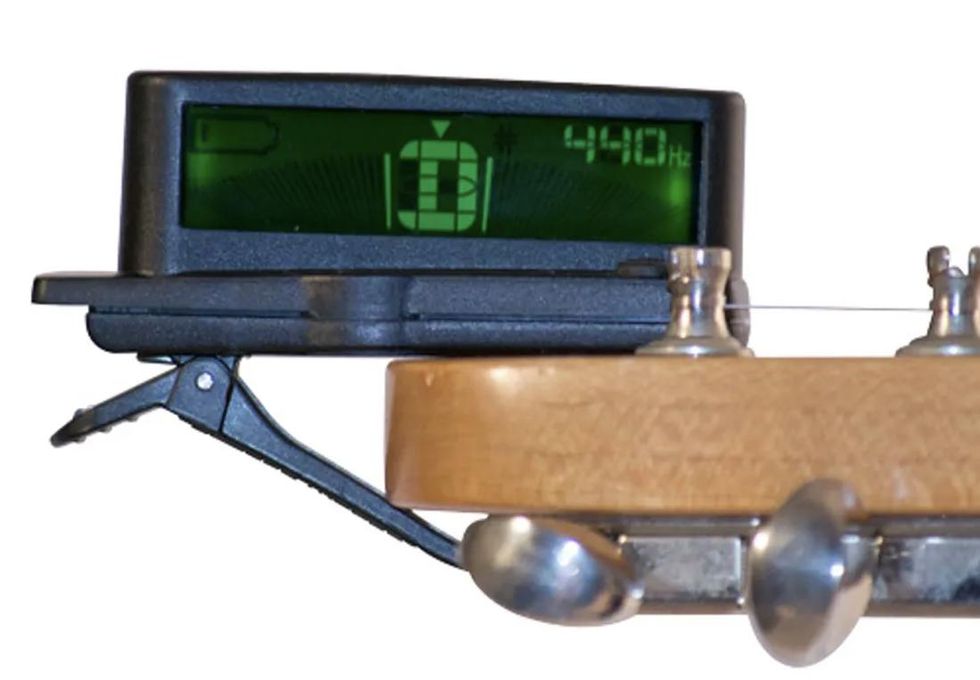
- Calibration: 435 Hz - 445 Hz
- Built-in piezo transducer
- Good tuning accuracy
- Limited display mobility
As a well-known name in the guitar accessories industry, it seemed only natural that Planet Waves would be in the clip-on tuner scene. Their Chromatic Headstock Tuner was designed with sleekness and portability in mind, and while it gets high marks in those regards, it's missing some key elements that separate the great clip-on tuners from the good ones.
Planet Waves' clip-on tuner is a sleek and slim piece, and it slid onto the headstocks of both the Tele and Martin while keeping a very low profile. The two-color LCD screen is angled at about 30 degrees from its base, with the tuner's single button—governing power and calibration—located at its edge. Because the tuner sat so close to each guitar's headstock, it was difficult for me to read the screen while I was tuning. The guitar's tuning pegs obstructed a lot of the view, so after hitting a note in the sitting position, I had to move the guitar closer to me and then adjust the tuning. Normally, I would have just moved the position of the LCD, but the screen is joined directly to the clip and completely immobile. This wasn't much of an issue when I had the guitars lying on a bench, but it was frustrating when I was sitting or standing with the guitar.
Compared to the Martin's onboard tuner, the accuracy of the Planet Waves tuner was pretty close, losing only a fraction of the accurate pitch on the higher strings. I feel that it could have been closer if the clip had a tighter bond with the headstock, which was a drawback of the design. Only a little strip of rubber on the bottom jaw of the clip kept the tuner in place, and it didn't take much to move it around by hand. With the Telecaster, the PolyTune was notably more effective in applying a precise tuning. The Planet Waves tuner simply wasn't able to pick up the resonance as well as the PolyTune could detect the notes from the jack output.
Street: $29.99
d'addario.com
Peterson StroboClip
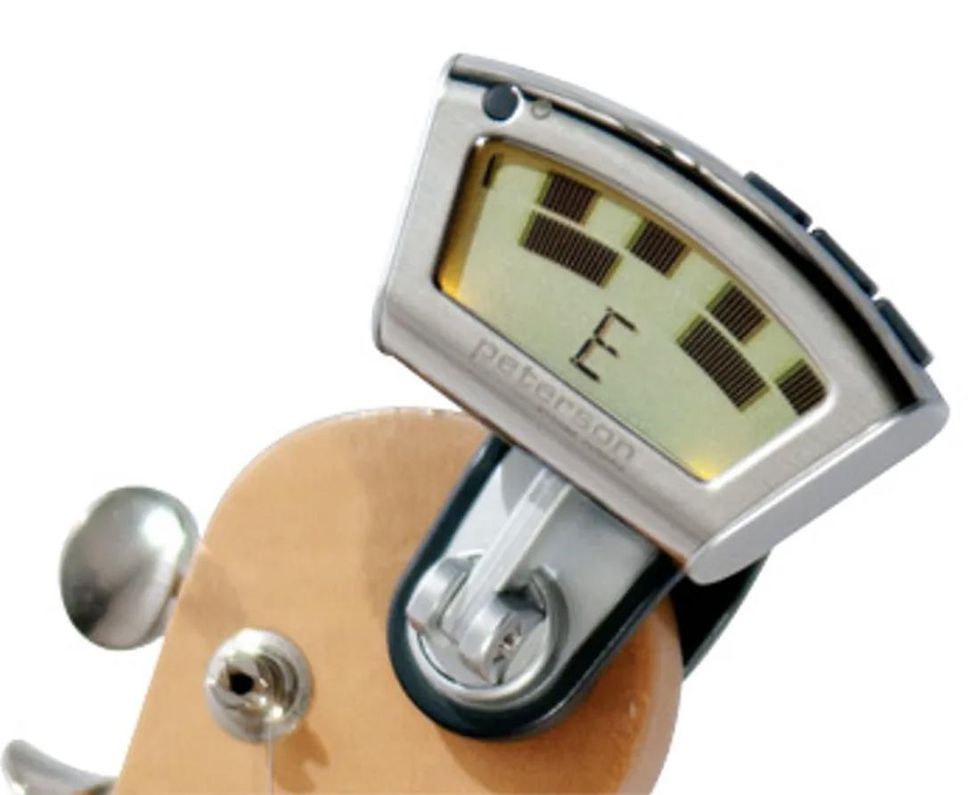
- Calibration: 400 Hz - 490 Hz
- Peterson rates precision +/-0.1 cent
- Includes "Sweetened Tunings" for various acoustic instruments (banjos, ukuleles, etc.)
- SUS feature for extended note readout for instruments with small amounts of sustain
The reputation of Peterson tuners is well-deserved. From the immensely popular StroboStomp pedal to the Strobe Center 5000-II, their tuners sit on the benches and pedalboards of some finest guitarists and guitar techs in the world, and with good reason—they're incredibly precise. Peterson's StroboClip tuner packs the 1/10 cent tuning accuracy that all of their tuning devices possess, along with a plethora of features and facets that you probably won't ever use—but they're readily available if you need them.
The StroboClip felt like a solid piece of kit in my hand, with a firm grip when clipped to my fingers, and a bright, powerful readout on its LCD. All of the unit's buttons are easily visible and accessible from the top of the panel, except for the power button, which was placed directly on the front. Both the tree and the screen could be moved and tilted for 360 degree movement, a major plus for convenient placement.
Embedded in the StroboClip are 39 calibrated tuning modes for a wide range of instruments—including guitars, banjos, basses, woodwinds, orchestral stringed instruments, and even sitars. After clipping the metal-faced gadget to the headstock of the Martin and going through the tuning process, it really gave the built-in F1 Aura a run for its money. When the F1 Aura registered the guitar perfectly in tune, the StroboClip countered with a reading of being off by fractions of cents. Even the PolyTune—which was plugged directly into the Tele—had issues keeping up with the StroboClip. Every string I plucked registered on the StroboClip with such pinpoint accuracy, that it was almost maddening getting the strobe to sit perfectly still.
Street: $69.99
petersontuners.com
[Updated 6/3/2021]
